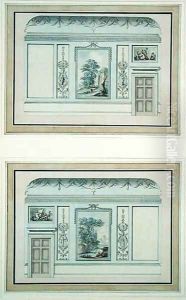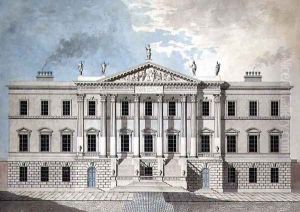John Yenn Paintings
John Yenn was an English architect who made considerable contributions to the architecture of the late 18th and early 19th centuries. Born on April 1, 1750, in London, he was the son of a builder, which likely influenced his early interest in architecture. Yenn was a pupil of the influential Sir William Chambers, one of the leading architects of the time, who was known for his neoclassical style and for designing Somerset House in London.
Yenn's training under Chambers provided him with a solid foundation in the principles of classical design, which he applied throughout his career. He became a skilled draughtsman and an adept designer, and his works reflected the popular neoclassical aesthetic of the period, characterized by its emphasis on symmetry, proportion, and the use of classical motifs.
In 1770, he became a student at the Royal Academy Schools, where he further honed his architectural skills. He exhibited at the Royal Academy of Arts from 1771 to 1795, showcasing his designs and elevating his status within the architectural community. His exhibition pieces often included designs for public buildings, villas, and monuments, revealing his versatility and creativity as an architect.
Yenn's professional career included several significant commissions. One of his notable projects was the remodeling of the Royal Naval Hospital in Greenwich, where he designed a new dining hall and other alterations. He also worked on the design of the Royal Navy's hospital at Haslar in Gosport. His work was not limited to public buildings; he also designed a number of private residences, including alterations to Basildon Park in Berkshire.
John Yenn became a fellow of the Royal Society in 1786, an acknowledgment of his contributions to architecture and the arts. He also served as a member of the Royal Academy council and, in 1791, was appointed as the Academy's Professor of Architecture, a position he held until 1820. In this role, he was responsible for delivering lectures and educating the next generation of architects.
Yenn's influence extended beyond his own designs. He played a role in the formation of architectural taste in Britain during his time and helped to shape the future of the profession through his teaching. He passed away on January 28, 1821, leaving behind a legacy as a significant figure in the progression of English neoclassical architecture. His work and his contributions to architectural education continue to be recognized by historians and scholars in the field.

